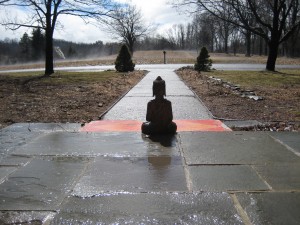Such an important time. I struggled mightily to offer the right guidance. I wrote an entire blog and then could not keep my eyes open as I read it. It’s not the right message; I was forcing it. I’ve let it go; maybe it’s a message for another time. I humbly approach The Oracle: What is the guidance for now? I ask.
The answer I receive is hexagram #9: The Taming Power of the Small, with stirrings in the first, fourth, and fifth places. The interplay of images: wind blowing over heaven. The wind has the power to gather the clouds, but it cannot make it rain. For this we must wait.
The hexagram is composed of five powerful yang lines restrained by the influence of a single weak yin line. The yin influence has its limits. Although it has the power to restrain it cannot overcome the obstacle.
The radiation in Japan can only be minimally restrained, the circumference of evacuation must widen. Global Supply Lines at Risk as Shipping Lines Shun Japan says a headline in the New York Times; the entire world is now impacted with nuclear fallout. It is time to restrain our global appetites. Think local. Eat local.
Qaddafi can be restrained from flying his planes and from committing out-and-out genocide, but as yet he cannot be stopped. Again the influence possible in this time of revolution is, at best, a restraining influence; we can only have limited influence on the course of the revolution. It must play out in its own way and its own time.
Republicans chip away at the unions, Roe v. Wade, and cast Obama as a foreign infidel. In response, the discontent of the masses is stirring but, as yet, exerts little restraint on the madness. Revolutions are happening, but the time has not ripened for major changes in governance, though the necessary ingredients for change are indeed beginning to coalesce.
We find ourselves in a time of waiting, with limited influence. What should we do? The charged first line of the hexagram reads:
“Return to the way.
How could there be blame in this?“
-From The I Ching, the Richard Wilhelm translation, p. 41.
This line depicts being stirred to act in response to the energy of now, of revolution; we all want to do something to help. We seek to push forward and make progress. We are met by obstructions. We are guided to return to the way—the Tao—action in conformity with the true nature of the situation.
It’s not time yet for the clouds to bring forth the rain, so we must take out the garbage, do our taxes, clean out the litter box, and make a commitment to daily self-cultivation. Prepare our bodies and our spirits for the coming changes. Focus on the doable and the necessary. “Tame ourselves, our greatness will build—and we can yoke it for further actions.” -From The Living I Ching by Deng Ming-Dao, p. 125
The moving line in the fourth place again counsels the need to exert restraint upon a being of power and influence, perhaps the mighty ego self who is frightened, angry, appalled, and pushes for immediate action. The restraint here is to stay aligned with the truth and restrain from unnecessary action. Don’t fight the racist, the birther. Know the truth of nuclear energy. The time of great influence is not yet upon us, but we can restrain ourselves, save our energy and cultivate right actions, good habits in our lives—habits consonant with the coming changes to the world. Rest assured, the rains are coming.
The charged line in the fifth place, the ruler of the hexagram, counsels us to restrain by embracing our interdependent and interconnected One World—to bond and share the wealth. This is the restraint that must be placed on individual greed that can only accumulate and care for itself with no thought to the needs of others. This One World is the one we must restrain ourselves and hold out for, not a world restored to power as was.
If we follow the restraining influence of the time of The Taming Power of the Small by forging ourselves in the proper way, The Book of Changes predicts a future of advanced civilization in hexagram #50: The Cauldron.
The Cauldron was a huge three-legged pot, cast of bronze, a sacred vessel unique to early Chinese civilization with huge handles flaring up like dragons. The Cauldron, used in the temples, stood directly in the fire to cook food for the nourishment of all during ceremonies of sacrifice and honor to God.
The Cauldron is a manmade object, one of the few depicted in the I Ching. This makes it highly significant for an oracle that focuses almost exclusively on the influences of the elements in nature. The ability of mankind to create a vessel that can be used to commune with God, as well as nourish the people, is given archetypal significance in this book of wisdom. It is possible for us to achieve an advanced civilization that can acquiesce to the higher self or spirit through right action and thereby care for and nourish all.
What a hopeful change the I Ching suggests as our future possibility! The Cauldron is, in fact, the hexagram that directly follows the hexagram of Revolution in the I Ching. Under the best of circumstances the world revolution now might forge a true cauldron. However, this is predicated upon acquiescing to the limited influence and restraint necessary in The Taming Power of the Small, for that is where we are now.
Now is the time to engage in the painstaking process of forging the giant cauldron. This translates, on an individual level, into cultivating our selves into beings that can channel right action. Specifically, we must restrain ourselves from the old ways and keep the light of truth lit in our hearts. The time for great influence has not yet come, but it will come, it always rains eventually.
For now, we must take out the garbage, do our taxes, clean the litter box, cultivate a daily spiritual practice, limit our appetites, tend to our organic gardens, and wait for the rain. We must store our energy, not waste it on fighting the talking heads. Nature is leading this revolution. Change is inevitable.
“Smallness tames. How slight the secret. How monumental the effect.”
-From The Living I Ching, by Deng Ming-Dao, p. 125.
Simply,
Chuck
If you wish to correspond, please feel free to post a comment below. And don’t forget to check out our facebook page at: Riverwalker Press on facebook where we post daily comments and quotes.


